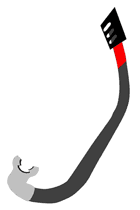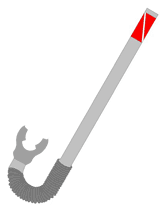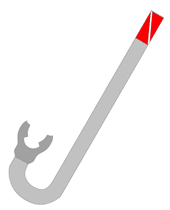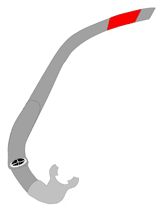SNORKELS
Snorkels have been around for a long time. And since many early scuba divers were freedivers or snorkelers before they took up scuba, it comes as little surprise that snorkels were quickly adopted by scuba divers as a way of conserving air on the surface, swimming back to the boat at a dive’s end, or as a way of comfortably breathing at the surface under most conditions.
How Snorkels Work
A snorkel seems simple enough – essentially, it’s a tube that you use to draw air from the surface while your face is in the water.
But there are more variables than might first occur to you. The size of the bore (tube) of the snorkel is important. It has to be large enough for you to take a deep breath quickly and easily, but not so large that it adds unnecessarily to the volume of air you must move back and forth on each breath.
The length of the snorkel is also important. It has to be long enough to stay above the surface while you swim, float, or otherwise rest or work at the surface. But too long a snorkel can be awkward, and can actually be harder from which to breathe.
Gear manufacturers are more than familiar with all of these factors, as well as the ergonomics that make a snorkel comfortable to use. So if you choose a reputable brand from your professional dive retailer, you can rest assured you’ll get a solid piece of essential dive gear that works well.
Snorkel Maintenance
Snorkels are very easy to care for – rinse with clean, fresh water after a dive, dry, and they’re ready for the next outing (some people advocate rinsing the mouthpiece in a mouthwash and then rinsing with fresh water). Snorkels that have clear silicone components should be stored away from black latex rubber items so the snorkel doesn’t discolor, and for longest life, snorkels should be stored away from heat sources and out of direct sunlight.
When & How to Buy
You’ll want your own snorkel before the first pool session of your open-water-diver training. It’s a personal piece of gear, and one that you will use often during your class.
While just about any snorkel will work with just about any conventional mask, some snorkel-and-mask combinations work best together (particularly those from the same equipment line). For this reason, it’s a good idea to buy your mask and your snorkel at the same time. As a mask is something you need to try on, the dive center is absolutely the best place to purchase a snorkel.
Tell your dive center professionals whether you’ll be using the snorkel for scuba diving, snorkeling, or a combination of the two, and what types of diving you most enjoy (or most hope to enjoy!). They’ll help you pick out a winning combination.
Which Kind is Best
As with all dive gear, you want to choose the snorkel that works best for the type of diving you’ll most often do. To do that, it helps to know what each type of snorkel is designed for.
Types of Snorkels
Virtually all snorkels sold today are self-clearing snorkels, which have a reservoir and a purge valve beneath the mouthpiece. Water splashing into the snorkel collects in the reservoir and drains out the one-way purge valve when you exhale.
Most snorkels today are also “contoured” to form around the side of the diver’s head. A contour snorkel lays close to the diver, and in currents or waves is more comfortable to use because it presents less resistance to the movement of water over it.
- Dry snorkels have a special top that prevents water from entering the snorkel bore when you are submerged or when seas are rough. This virtually eliminates the need to purge water from the snorkel before use.

- Flex snorkels have a flexible lower section that allows the snorkel mouthpiece to drop away from your face when you are breathing from your scuba regulator. Flex snorkels can be straight or contoured, and the flex feature can also contain a purge or other features.

- Folding snorkels are popular with wreck divers and other divers trained to use guidelines in overhead environments. That way the snorkel can be in a BC pocket and out of the way during the part of the dive when a snorkel cannot be used (such as inside a shipwreck), but it can be retrieved and used once a diver heads back to the surface.
- J-Snorkels were among the first snorkel designs. They are commonly sold in sporting goods stores, but are less suitable for scuba diving as the design tends to trap water in the bottom of the deep “J” shape, and the straight portion of the tube presents more resistance to the water while the diver swims.

- Snorkels with dedicated bores have two bores within the snorkel tube – one is used for inhaling, the other for exhaling. The additional bore allows water to be more easily expelled at the surface, making this one of the easiest snorkel designs to use.

Scuba divers generally prefer a streamlined snorkel that stays out of the way when not in use, and clears with a single exhalation. Snorkelers usually look for the easiest-breathing snorkel they can find, even if it is somewhat larger. It’s not unusual to encounter divers who own two snorkels – one that they use for scuba and free-diving, and another that they use for snorkeling outings.